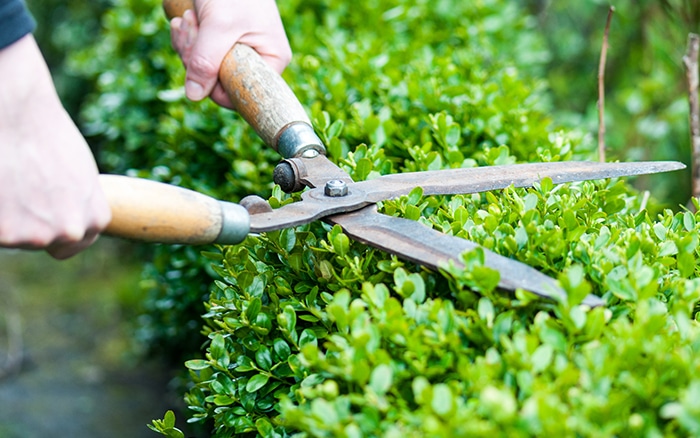As a garden feature, hedging has it all. It’s time to hedge your bets because I’m going share the reasons why all gardens should be bestowed in beautiful, bountiful hedgerows.
Boundary benefits
Compared to walls or fences, hedging wins heads and shoulders. One of the best gains we get from hedging in the garden is that it’s a cheap, easy-to-plant and attractive boundary which provides structure to the garden, perfect for wildlife and nesting birds.
For urban plots, you’ll find that hedging is handy for cutting down on noise pollution, as well as actual pollution because the plant will naturally filter the air.
Unlike other boundary structures, hedges don’t need year after year maintenance. They’re long-lasting and about as natural as it gets. Yet, they can offer the same level of privacy and serenity that you and your garden need.
Prune for purpose
For hedges in place, pruning is a must. You should trim new evergreen hedges in spring as soon as the risk of frost has passed, which may otherwise damage new shoots. Deciduous growth is best pruned in winter, while they are dormant, and any established hedges should be pruned annually to keep them looking good.
Preserving a well-pruned hedge will help to keep the growth healthy, vigorous and dense—nobody likes sparse shrubbery.

It’s also worth bearing in mind that even your garden boundaries need feeds to keep them growing well. Often overlooked, garden hedging will benefit hugely from regular plant feed to keep the nutrient intake high and the foliage growing high too.
Dense as a fence

If your thickets are thinning a tad, there are hedge plant varieties which naturally grow dense foliage to give the best coverage. Yew is a fantastic choice for a formal dense hedge, but it is slow-growing and expensive. However, another evergreen is Portuguese laurel. The variety ‘Variegata’ has white-margined leaves to add some garden interest.
Though evergreens offer the most for privacy year-round, deciduous hedges can also look great and have the benefit of filtering wind in the winter and avoiding damage.
Go for something like a beech hedge, which over winter, holds onto its brown leaves and looks really striking.
Privet, beech and hornbeam hedging are all garden staples. These top sellers remain popular because they’re easy to care for and just do the job well. Pleached hornbeam is particularly useful for gaining privacy in large gardens, due to its height—whilst having the convenience of being able to see below them, so you don’t lose any space. These are a brilliant addition to suburban gardens.
Flowering favourites
Rosa Rugosa is a fast-growing hedging plant that forms a dense barrier, it’s perfect for informal gardens and seaside locations too. Variety ‘Rubra’ flowers in fragrant and magenta blooms throughout summer and into autumn.
Else, you might decide to go for something that offers more than delightful decoration. Escallonia rubra ‘Crimson Spire’ flowers in deep crimson colours over the summer and autumn but is also a great nectar source for pollinators like bees and butterflies.

Berberis darwinii (Darwin’s barberry) not only gives floral satisfaction when used for garden hedging but has spiny-toothed leaves to present protected nesting sites to birds and even fruits in black/blue berries.
Nature intended

Hedging has the opportunity to provide great food sources for garden wildlife. Many of them bear berries across the year to the benefit of birds, and in my garden at home, that’s exactly what I’ve done.
One of the biggest benefits of something like Pyracantha ‘Orange Glow’ is that you get garden decoration, shelter for wildlife, beautiful orange berries for food sources and, because it has spiny branches, it also delivers great garden security too. Planting an all-rounder like this gives your garden so much for so little.
Historically, hawthorn hedging has given us many of our field boundaries—the perfect habitat for wildlife. It’s dense and has a thicket of thorns, which makes pruning tricky, but gives great roosting opportunities for birds.
Trim n’ trained
On the other end of the spectrum, you might have a garden which prefers a more manicured look, and for this, clipped box works a dream. Traditionally used for formal garden topiary, this plant is really useful for hedges sited in shady parts of the plot.
You will need to prune this two or three times during growing season. With the spread of box blight and box tree caterpillar, many have focused on finding alternative evergreen plants for formal plantings.

By far the most fast-growing variety, Leyland cypress, will give you quick results. But, be warned, that it’s in need of regular trimming to keep it under control, else can grow up to 30m if left to its own devices.
Tip:
Sweep hairy-leaved houseplants,
like African Violets, free of dust with a dry
paintbrush so they access more
sunlight.
Whatever plot you’ve got, there’s a hedge to give it the edge! Get planning your hedging endeavours for the year ahead now and you’ll enjoy a private, plentiful and splendid garden hereafter!
Happy gardening everyone!
Reader questions
When’s the best time to prune wisteria?

Prune regularly to keep growth in check and encourage flowering, once in summer and once in winter. Mostly you just need to cut back the young whippy growth and give it a tidy up when dormant but older plants might need spent growth removed.
When is the best time to re-lay the lawn with fresh grass seed?

Early autumn or late spring is the best time for this job, when the soil is warm, there’s plenty of moisture and the weather isn’t too hot or cold. Rid the thatch and moss using a scarifier, which opens up the law surface for new seeds. Once seeded, you must wait for the seeds to germinate before mowing.

Leave A Comment